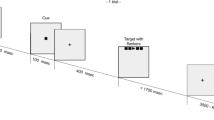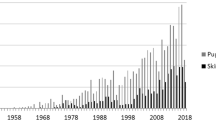Summary
Quantitative measures of saccadic eye movements were examined in 52 lead exposed autobody shop workers and 52 age matched controls with no history of occupational lead exposure. Three characteristics of saccadic eye movements were studied: 1) saccade accuracy; 2) number of overshoots; and 3) maximum velocity. The results indicated that workers exposed to inorganic lead showed a decrease in saccade accuracy and an increase in overshoots compared with controls. Saccade maximum velocity was lower in lead exposed workers than in controls but the difference was just short of statistical significance. Correlations between measures of saccadic eye movements and indicators of lead absorption—blood lead (Pb-B) and zinc protoporphyrin (ZPP) levels-were analyzed in the lead exposed workers. Saccade accuracy was negatively correlated with both Pb-B and ZPP levels. The number of overshoots was not correlated with either Pb-B or ZPP levels. Saccade maximum velocity was not correlated with Pb-B, however, there was a significant negative correlation with ZPP. Age effects observed in the control group were disrupted in lead exposed workers. In addition, saccadic eye movements in younger workers (below 30 years old) were more affected by exposure to inorganic lead than were saccadic eye movements in older workers (50 years and older). It is proposed that these findings are consistent with a relatively rapid buildup of metabolically active lead burden observed in the study group. The data suggest that quantitative assessment of eye movements may be an important tool for studying subclinical central nervous system (CNS) dysfunction due to inorganic lead exposure.
Similar content being viewed by others
References
Baloh RW, Spivey GH, Brown CP, Morgan D, Campion DS, Browdy BL, Valentine JL, Gonick HC, Massey FJ, Culver BD (1979) Subclinical effects of chronic increased lead absorption—a prospective study. II. Results of baseline neurologic testing. J Occup Med 21:490–496
Baloh RW, Langhofer L, Brown CP, Spivey GH (1980) Quantitative eye tracking tests in lead workers. Am J Ind Med 1:109–113
Blumberg WE, Eisinger J, Lamola AA, Zuckerman DM (1977) Zinc protoporphyrin level in blood determined by a portable hematofluorometer: A screening device for lead poisoning. J Lab Clin Med 89:712–723
Fischbein A, Eisinger J, Blumberg WE (1976) Zinc protoporphyrin determination: A rapid screening test for the detection of lead poisoning. Mt Sinai J Med 43:294–299
Fischbein A, Thornton JC, Lilis R, Valciukas JA, Bernstein J, Selikoff IJ (1980) Zinc protoporphyrin, blood lead and clinical symptoms in two occupational groups with low-level exposure. Am J Ind Med 1:391–399
Glickman L (1982) Oculomotor indicators of inorganic lead neurotoxicity. Doctoral Dissertation. Graduate Center: The City University of New York
Glickman L, Valciukas JA, Lilis R, Weisman I (1981) Oculomotor dysfunction in automobile production workers exposed to inorganic lead. Paper presented at the XX International Congress on Occupational Medicine, Cairo, Egypt, Sept. 26–29
Grandjean P, Arnvig E, Beckmann J (1978) Psychological dysfunctions in lead-exposed workers. Relation to biological parameters of exposure. Scand J Work Environ Health 4:295–303
Hänninen H, Hernberg S, Mantere P, Vesanto R, Jalkanen M (1978) Psychological performance of subjects with low exposure to lead. J Occup Med 20:683–689
Hänninen H, Mantere P, Hernberg S, Seppäläinen AM, Kock B (1979) Subjective symptoms in low-level exposure to lead. Neurotoxicol 1:33–347
Hogstedt C, Hane M, Agrell A, Bodin L (1983) Neuropsychological test results and symptoms among workers with well-defined long-term exposure to lead. Br J Ind Med 40:99–105
Horvath EP, Ilka RA, Boyd J, Markham T (1981) Evaluation of the neurophysiologic effects of 1,2-propylene glycol dinitrate by quantitative ataxia and oculomotor function tests. Am J Ind Med 2:365–378
Lilis R, Blumberg WE, Eisinger J, Fischbein A, Diamond S, Anderson HA, Selikoff IJ (1977a) Lead effects among secondary lead smelter workers with lead levels below 80 micrograms/100 ml. Arch Environ Health 32:256–266
Lilis R, Fischbein A, Eisinger J, Blumberg WE, Diamond S, Anderson HA, Rom A, Rice C, Sarkosi L, Kon S, Selikoff IJ (1977b) Prevalence of lead disease among secondary lead smelter workers and biological indicators of exposure. Env Res 14:255–285
Lilis R, Valciukas JA, Kon S, Sarkosi L, Campbell C, Selikoff IJ (1982) Assessment of lead health hazards in a body shop of an automobile assembly plant. Am J Ind Med 3:33–51
Mantere P, Hänninen H, Hernberg S (1982) Subclinical neurotoxic lead effects: Two-year follow-up studies with psychological test methods. Neurobehav Toxicol Teratol 4:725–727
Repko JD, Corum CR, Jones PD, Garcia LS Jr (1978) The effects of inorganic lead on behavioral and neurologic function. Final Report, DHEW Publication No 78–128, NIOSH
Seppäläinen AM, Hernberg S (1972) Sensitive technique for detecting subclinical lead neuropathy. Br J Ind Med 29:443–449
Seppäläinen AM, Hernberg S (1980) Subclinical neuropathy. Am J Ind Med 1:413–420
Seppäläinen AM, Tola S, Hernberg S, Kock B (1975) Subclinical neuropathy at “safe” levels of lead exposure. Arch Environ Health 30:180–183
Singer R, Valciukas JA, Lilis R (1983) Lead exposure and nerve conduction velocity. The differential time course of sensory and motor nerve effects. Neurotoxicol 4:193–202
Specchio LM, Bellomo R, Pozio G, Dicuonzo F, Assenato G, Frederici A, Misciagna G, Puca FM (1981) Smooth pursuit eye movements among storage battery workers. Clin Toxicol 18:1269–1276
Spivey GH, Baloh RW, Brown CP, Browdy BL, Campion DS, Valentine JL, Mergan DE, Culver BD (1980) Subclinical effects of chronic increased lead absorption-a prospective study. III. Neurologic findings at follow-up examination. J Occup Med 22:607–612
Taylor JR, Selhorst JB, Houff SA, Martinez AJ (1978) Chlordecone intoxication in man. I. Clinical observations. Neurology 28:626–630
Troost BT, Weber RB, Daroff RB (1972) Hemispheric control of eye movements. I. Quantitative analysis of refixation saccades in a hemispherectomy patient. Arch Neurol 27:441–452
Tsutsui J (1980) Clinical and pathological studies of eye movement disorders in Minamata disease. In: Merigan WH, Weiss B (eds) Neurotoxicity of the visual system. Raven Press, New York, pp 187–202
Valciukas JA, Lilis R, Eisinger J, Blumberg WE, Selikoff IJ (1978) Behavioral indicators of lead neurotoxicity. Results of a clinical field survey. Int Arch Occup Environ Health 41:217–236
Valciukas JA, Lilis R (1982) A composite index of lead effects. Comparative study of four occupational groups with different levels of lead absorption. Int Arch Occup Environ Health 51:1–14
Author information
Authors and Affiliations
Additional information
Part of this study was presented at the XX International Congress on Occupational Medicine, Cairo, Egypt, Sept. 26–29 (1981)
This study was supported in part by NIEHS grant ES00928 of the National Institute of Health, US Department of Health and Human Services
Rights and permissions
About this article
Cite this article
Glickman, L., Valciukas, J.A., Lilis, R. et al. Occupational lead exposure. Int. Arch Occup Environ Heath 54, 115–125 (1984). https://doi.org/10.1007/BF00378514
Received:
Accepted:
Issue Date:
DOI: https://doi.org/10.1007/BF00378514




